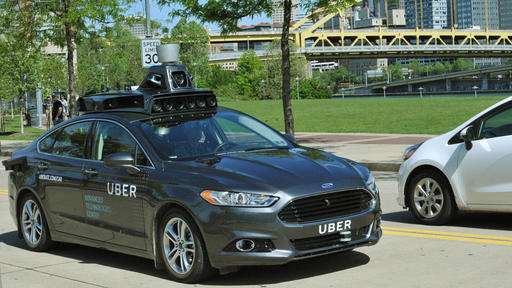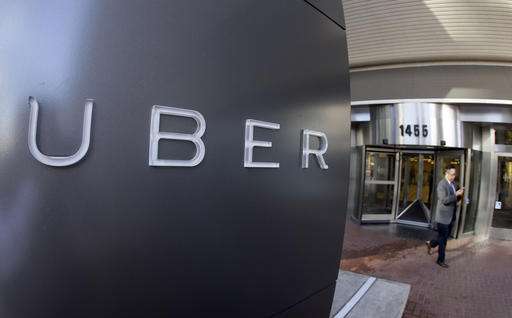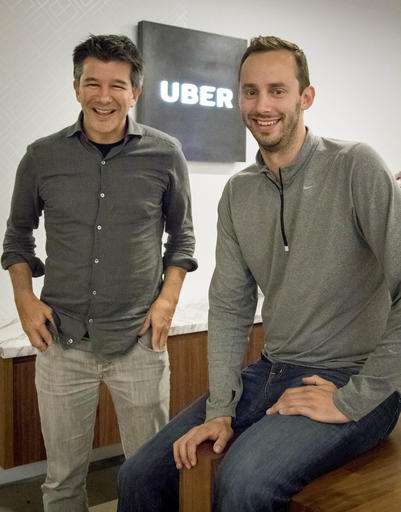Self-driving Uber cars to carry passenger soon in Pittsburgh

In a few weeks, Uber will start using self-driving cars to carry passengers in Pittsburgh, raising the stakes in the fast-track race to deploy autonomous vehicles.
The ride-hailing company said Thursday that customers will be able to opt into the test program, which will use autonomous Ford Fusions summoned by the touch of a smartphone. Although other companies are testing self-driving cars on public roads, this is the first time the public will get access to them.
The rides, which come with a human backup driver to handle situations that the autonomous cars haven't seen, will be free to those willing to take part, the company said.
Uber, which has a self-driving research lab in Pittsburgh, has no immediate plans to deploy autonomous cars beyond the Pittsburgh experiment. But its CEO, Travis Kalanick, has said that without drivers, the cost of hailing a ride will be cheaper than owning a car.
Kalanik, in a Thursday interview with The Associated Press, said development of autonomous cars is paramount for the 7-year-old San Francisco-based company. "We're catching up fast, but we need to get to No. 1 quick," he said. "We've got to be laser-focused on getting this to market, because it's not a side project for us. This is everything. This is all the marbles for Uber."
Uber also announced a $300 million alliance with Volvo to supply vehicles and technology, and the acquisition of an autonomous big-rig startup in San Francisco as it pushes forward with self-driving vehicles. The announcements may push it ahead of its prime competitor, Lyft, which earlier this year took a $500 million investment from General Motors.
They're part of a flurry of deals between Silicon Valley tech companies, traditional automakers and ride-hailing companies as they vie for leadership in what's being billed as the next step in the way we all will get around. Google parent company Alphabet Inc., which has been testing autonomous cars on public roads since 2009, is among the leaders, but has not carried passengers.
Uber's move to carry people with autonomous vehicles is not surprising, given the company's history of pushing into gray areas where there is little or no regulation, said Bryant Walker Smith, a University of South Carolina professor who studies self-driving technology.

Pennsylvania, he said, has no laws governing autonomous cars and how they relate to ride-hailing, but local laws may require a driver behind the wheel. By using human backup drivers, Uber basically is going to test the technology and take people along for the ride, he said.
"Part of this is marketing in the sense that they're going to be doing continued research and development of these systems, but they're going to carry people in the process," he said.
Walker Smith predicted that drivers often will have to intervene in Pittsburgh, with its winding, hilly roads and vast number of bridges. The city also gets a fair amount of snow, which can cover lane lines and trick autonomous car sensors.
Use of the backup drivers also is an acknowledgement that autonomous driving systems to date cannot handle the wide range of unpredictable circumstances on public roads, Walker Smith said.
Timothy Carone, a Notre Dame professor and author of "Future Automation: Changes to Lives and to Businesses," said Uber is trying to get first mover advantage by putting its cars on the road before competitors. But unlike Tesla Motors, which put semi-autonomous technology in the hands of individual customers, Uber is mitigating the risk by putting its own drivers in the front seat.
"This is a way to get autonomous cars out there and accepted and increase the adoption rate," Carone said. "It will take a decade of testing before an 18-year-old can get in the car and tell it where to go."
Kalanick wouldn't speculate on when Uber might be ready to dispense with the human driver, saying that full automation can only be used now in limited places with little traffic. That's very different from the relative chaos of even a small downtown, much less a big city where drivers don't always follow the rules of the road.
Carone expects Uber competitors to accelerate self-driving tests or merger plans. But he thinks they will all adopt the same risk-management approach as Uber. Ford Motor Co., for example, said earlier this week that it will have a fully autonomous car with no steering wheel or pedals on the road by 2021, but it will only be used by car-sharing services and won't be sold to individual customers.

Uber announced a $300 million deal for Volvo to provide SUVs to Uber for autonomous vehicle research. Eventually the Volvo SUVs will be part of the self-driving fleet in Pittsburgh. Volvo will develop base vehicles for research and both companies will design autonomous vehicles on their own.
Uber also announced that it is acquiring a self-driving startup called Otto that has developed technology allowing big rigs to drive themselves.
With Otto, Uber gets a fast infusion of self-driving expertise, including Otto co-founder Anthony Levandowski, one of the founding fathers of autonomous technology.
Though the Google car project just lost its director, Chris Urmson, it has a big head start on Uber and others. Its leaders have suggested they could launch public pilot tests of cars with no steering wheels or pedals in the next year or two.
Putting robotic vehicles on the road has been an obsession for Levandowski. One earlier effort, a self-driving motorcycle named Ghostrider, is now in the Smithsonian's National Museum of American History.
Until the start of this year, Levandowski was at Google, but he left to found Otto with two other former Google employees.
© 2016 The Associated Press. All rights reserved.

















